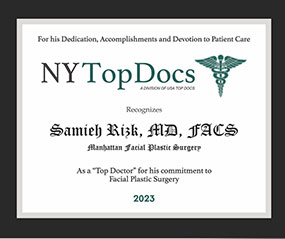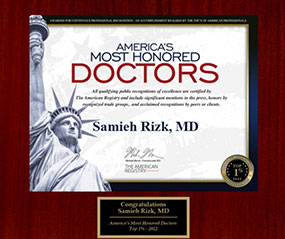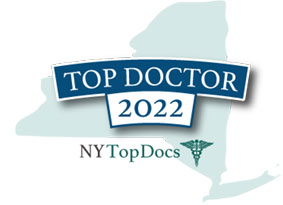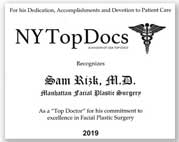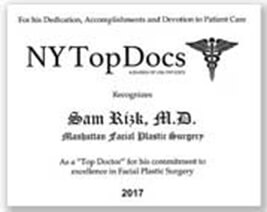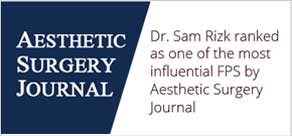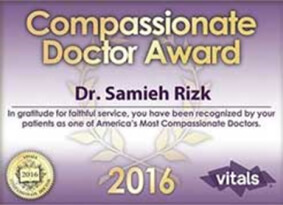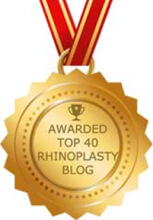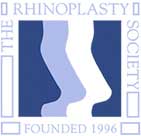What is a rhinoplasty?
Rhinoplasty or “nose job” is a surgical procedure to refine and/or reshape the nose. It can change the size, length, width, projection, bridge or tip. It can also straighten a crooked nose. Rhinoplasty is a cosmetic procedure and sometimes it is done at the same time as a functional procedure such as septoplasty (a procedure done on the nasal septum, which is a structure separating the right and left nasal cavities) to straighten it.
What are the benefits of rhinoplasty?
Benefits may range from improved breathing to an enhanced appearance and self-confidence. According to Dr. Sam Rizk, the nose is a central facial structure and impacts beauty and facial harmony to a large degree. The shape of the nose can give a more or less sophisticated appearance, a long or drooping nose can make a person look older, and a bulbous tip can make a person look more ethnic. Visual improvement from a rhinoplasty can be subtle in a person with a minimal deformity or more dramatic in a person with a significant deformity.
What is the satisfaction rate with rhinoplasty?
In Dr. Rizk’s practice, 90 percent of patients are happy with their results and 10 percent feel they could have had a better nose. Some of the latter (10 percent) may choose to do a touchup or revision rhinoplasty. Some patients are unrealistic about their expectations and their thicker skin may not shrink after surgery as much as they would like. Dr. Rizk is very honest with patients and explains this before the surgery. Also, some patients may form more scar tissue inside the nose making it less defined. If a patient is not satisfied with their rhinoplasty and if Dr. Rizk feels something can be done to improve the results, he will do it.
However, if Dr. Rizk feels the patient is unrealistic, he will choose not to re-operate. Also, some patients have body dysmorphic disorder and Dr. Rizk chooses not to operate on them. Dr. Rizk makes most patients happy but the few unhappy ones are also a reality of rhinoplasty. It is important to be realistic in your expectations and understand possible complications which are rare but may include stuffiness, scar tissue, bleeding, asymmetric results from scar tissue, and the possible need for revision.
Am I a good candidate for rhinoplasty?
Dr. Sam Rizk, a nose specialist and double board-certified facial plastic surgeon in New York City, will operate on selected patients whom he deems to be healthy (physically and emotionally ) and psychologically stable and have realistic expectations. Dr. Rizk will sometimes not recommend surgery if he feels he cannot meet the patient’s expectations or if the patient’s requests do not coincide or agree with his artistic sense. Rhinoplasty surgery is a very precise and artistic operation and results cannot be 100% guaranteed and some patients, although rare, may require a revision rhinoplasty. If a patient cannot accept the risk of a possible revision, even if it is very rare, they should not undergo rhinoplasty in the first place.
What is revision rhinoplasty?
Revision rhinoplasty or secondary rhinoplasty is a rhinoplasty procedure used to revise or fix a past procedure. It may be necessary because of an overly aggressive previous procedure or because of poor healing. Dr. Sam Rizk does a large number of revision rhinoplasty procedures every week on a regular basis. It is a more complex procedure and requires more surgical time.
What is septoplasty?
Septoplasty is a procedure done from inside the nose to repair a crooked or deviated nasal septum. The septum is the structure that separates the right and left nostrils and goes back far into the nasal cavity. The septum consists of cartilage and bone. Symptoms of a deviated and crooked nasal septum could include difficulty breathing through the nose or sinus problems. Repairing the nasal septum can be done at the same time as a rhinoplasty if medically indicated.
How do I know if I have a deviated nasal septum?
If you have difficulty breathing through your nose and you do not like the way your nose looks, seek a consultation from a board-certified facial plastic surgeon. Upon examining your nose, a facial plastic surgeon will determine if you have a deviated septum and if it is significant enough to cause nasal blockage. A CT scan (a special x-ray of the nose and sinuses) may be ordered to determine the extent of septum deviation and to review the sinuses.
How do I choose a surgeon?
Do your homework, research the surgeon online, and look at reviews, but be careful – a bad review does not mean you have a bad doctor. Online reviews are unregulated and can arise from a number of situations unrelated to a surgeon’s patients or practice. So research if your surgeon teaches at conferences, look at the surgeon’s awards given such as best doctors, etc. Castle Connelly is a prestigious Best Doctor’s award given based on a vote from other doctors. Look at the photo gallery and most importantly choose a surgeon who does a lot of nose surgery and who is a specialist in rhinoplasty.
Additionally, a facial plastic surgeon specializes in facial surgery and does not do body work, whereas a general plastic surgeon does face and bodywork. Make sure your surgeon does rhinoplasty on a regular basis many times per week and make sure your surgeon is board certified by the American Board of Facial Plastic and Reconstructive Surgery (www.abfprs.org). Dr. Sam Rizk is a double board-certified facial plastic surgeon whose practice specializes in noses. Dr. Rizk was voted Best Rhinoplasty Surgeon by Castle Connelly by his peers in 2008. Dr. Rizk does not do body plastic surgery.
At what age can rhinoplasty be performed?
Typically, teenagers can undergo rhinoplasty from age 14/15. These are the ages when the nose is fully formed and when the teenagers are developing self-image and confidence. Some teenagers also have functional issues with breathing from sports-related injuries which need to be addressed as well. Dr. Sam Rizk, a New York City facial plastic surgeon, performs rhinoplasty on teenagers only if the teenager really wants it, in addition to the parent. Dr. Rizk will not perform rhinoplasty on a teenager for the parent’s wishes alone. The teenager has to be mature enough to be able to understand the procedure and recovery process.
Is rhinoplasty painful?
Dr. Sam Rizk’s patients rarely complain of pain following rhinoplasty. According to Dr. Rizk, maybe 1 or 2 patients out of 100 will have to take the prescribed pain medicine. Some discomfort is expected and usually relieved with extra strength Tylenol. The tip of the nose is usually numb for a few months following the surgery.
Dr. Rizk uses minimally invasive endoscopic 3D techniques (see videos from Doctor’s show on the homepage) where smaller incisions are made inside the nose and the nasal structure is altered from under the muscle layers without damaging this overlying muscle. By precisely altering the nasal structure while visualizing it with a high-definition 3D telescope system, the blood vessels and muscle covering the nasal skeleton are not damaged which results in less pain, bruising and swelling.
Additionally, the high-definition 3D telescopes allow precise visualization of the nasal structures through smaller internal incisions, thus, enabling Dr. Rizk to change the nose accurately with less risk of over-reduction or under-reduction of the nose and a more rapid painless recovery.
How long does rhinoplasty take?
The time it takes to do a rhinoplasty depends on many factors such as whether it is a primary or secondary rhinoplasty and whether grafts are needed or not, whether it is an open versus closed (endonasal) rhinoplasty and on the thickness of the skin as well. On average it takes between 1.5 – 2 hours to do a rhinoplasty by Dr. Rizk. That being said, Dr. Rizk does not look at the clock when operating; he feels this is an artistic operation and he does not rush in any of his surgeries, leaving more time than is needed to do every procedure.
Revision rhinoplasty may take up to 3 – 4 hours depending on scar tissue and graft usage and harvesting tissue from other areas. Dr. Rizk performs a very meticulous operation and does not rush. Dr. Rizk also feels that surgical times longer than 4 hours result in diminishing returns due to irreversible stretching of the skin and sometimes prolonged swelling. Furthermore, the nose swells up so much with longer surgical times that it becomes impossible to assess nuances in the shape of the nose. This is why Dr. Rizk spends time creating his surgical plan prior to the surgery with detailed diagrams to decrease operative time.
What kind of anesthesia is required?
Rhinoplasty is safest with general anesthesia where the airway is protected with a tube. Sedation anesthesia may be used in selected cases as indicated. General anesthesia can be performed where the patient is breathing on his/her own as well.
Where does Dr. Rizk perform his rhinoplasty surgery?
Dr. Rizk performs the rhinoplasty in his Park Avenue Certified Operating Room Facility. This facility is the ultimate in safety and privacy and has the latest most sophisticated modern equipment for rhinoplasty. The office-based facility has only Board Certified anesthesiologists and does not use nurse anesthetists for anesthesia. Additionally, the post-surgery recovery rooms have a nurse-to-patient ratio of 1:1 versus hospitals which may have 1 nurse for 6 or more patients. Dr. Rizk has all the emergency equipment required in a hospital for any emergency that may arise. Dr. Rizk also has admitting privileges in many local hospitals on the upper east side of New York City in close proximity to his facility. After the patient recovers in a private suite, he/she is discharged and follows up with Dr. Rizk in a week. Sometimes, patients from out-of-town stay in a hotel and this is arranged by Dr. Rizk’s office staff. Sometimes the patient may request a private duty nurse and this can be arranged as well with Dr. Rizk’s staff. Occasionally, Dr. Rizk does rhinoplasty surgery at hospitals as well.
During a consultation, does Dr. Rizk formulate and discuss a plan for rhinoplasty?
If Dr. Rizk determines that you are a good candidate for rhinoplasty, he will formulate a plan and discuss what you would need in the procedure. He will gather information and discuss if open or closed approaches should be used and if he will use cartilage for grafts or implants. If he decides to use cartilage, he will also discuss possible sources, such as the septum, ear or rib cartilage.
What does a rhinoplasty entail and what kind of rhinoplasty procedures are available?
Surgical techniques for reshaping the nose may vary but in general, incisions are made either inside the nose (closed) or on the piece of skin separating the nostrils (open) and the skin and soft tissue envelope is separated from the cartilage and bone framework of the nose. The framework is reshaped and sculpted and the overlying soft tissue envelope is then replaced and a splint is applied to the nose for a week to help keep this new shape in place.
Open rhinoplasty (external) is done from a small incision on the columella (the center piece of skin in the middle separating the right and left nostrils). Endonasal (closed) rhinoplasty is performed from small incisions inside the nose. The 3D endoscopic high-definition rhinoplasty techniques can be used with endonasal and open approaches. Dr. Rizk performs most primary rhinoplasty surgeries with the endonasal 3D high-definition approach. Dr. Rizk also performs open rhinoplasty in selected cases with thick skin where multiple grafts are needed and in some revision rhinoplasty procedures.
Dr. Rizk does not like to limit his approach to ONLY open or ONLY closed procedures as some surgeons do. He feels there are indications for both the open and the closed approaches. An alar base reduction or nostril reduction is sometimes needed with rhinoplasty and Dr. Rizk performs this procedure from a small incision on the inside of the nostril, not on the outside of the nostril.
I have thick skin on my nose, could I still obtain a good result?
As the Ethnic population in the United States is increasing, Dr. Rizk does a lot of rhinoplasty on patients who are ethnic (Asian, Middle Eastern, African American, Latino/Hispanic) with thick skin as well as some Caucasian patients with thick skin. Patients with thick skin on their nose and large pores can obtain an excellent reduction in most cases with the use of grafts, implants, as well as 3D defatting of the nasal tip. Dr. Sam Rizk states that ear cartilage is too soft and weak to be able to define the nasal tip (but it can be used for other types of grafts in the nose). Far superior and stronger grafts include the septum or rib.
Medpor is also an excellent implant for defining the nasal tip and bridge and it does not resorb with time and integrates well with the nose. Dr. Rizk custom sculpts the Medpor implant to fit your nose during your procedure, It is not a one-size-fits-all implant. Rib cartilage is also adequate in strength but may warp and absorb slightly with time. Dr. Rizk does not like silicone implants in the nose because they do not integrate well and move with time. Dr. Rizk has come across a few patients with thick skin whom he could not help with a standard rhinoplasty and who had a condition known as rhinophyma and these patients required further treatment with laser to shrink the skin and pores.
How about the recovery?
In addition to the use of the 3D high-definition telescopes and the smaller incisions, Dr. Rizk recommends a special type of vitamin K to be taken before and after surgery which also reduces swelling and bruising. Dr. Rizk also gives the herbal supplement arnica to be used before and after surgery in his Rapid Recovery Surgical Packet. Dr. Rizk also uses a tissue sealant inside the nose which seals blood vessels and decreases bruising. He also does not close the incisions inside the nose completely; instead, he approximates the incisions, which allows blood and fluid to drain instead of collecting under the skin after surgery. The incisions when approximated close on their own after a few days. This tissue approximation instead of a tight closure functions as a natural drain which aids in rapid recovery.
Dr. Rizk also asks his patients to avoid aspirin products for 2 weeks before and 2 weeks after nasal surgery. He also believes that other herbal supplements such as St John’s wart, fish oil, vitamin E and Ginko Biloba promote bleeding and bruising and should be avoided as well. Vitamin C is an excellent medication to start 2 weeks before and continued for 2 weeks after rhinoplasty (1000mg per day) because it decreased swelling and promotes healing.
Lastly, Dr. Sam Rizk recommends a diet free of regular salt. Kosher sea salt is much better to use than regular salt. Some patients also benefit from light therapy, lymphatic drainage, or acupuncture to further decrease any persistent bruising or swelling. Dr. Rizk may recommend these treatments after the surgery and will refer you to a specialist. Light therapy is used by NASA to promote healing of wounds in space where light is scarce.
When can I look presentable after rhinoplasty?
With Dr. Rizk’s rapid recovery techniques, you would look presentable where it would be unrecognizable that you had a rhinoplasty a week on average following the surgery. The nasal splint is removed a week following the surgery. You may be asked to use tape at night for a few weeks to decrease swelling if your skin is thick. The final result takes 1 year or longer in a revision rhinoplasty.
When can I go back to exercising after rhinoplasty?
Moderate exercise can be resumed 2 weeks after rhinoplasty. Yoga and heavy exercise as well as contact sports should be avoided for 6 weeks after rhinoplasty.
When can I fly after rhinoplasty?
You can fly 1 week after rhinoplasty surgery. Most out-of-town patients who undergo rhinoplasty with Dr. Sam Rizk stay in New York City for 1-week minimum. Dr. Rizk’s staff can make arrangements for hotels in NYC, if necessary.
When can glasses be worn after rhinoplasty?
Glasses should be avoided for the first 6 weeks after rhinoplasty unless they are light and can be taped to the forehead. Sometimes Dr. Rizk will allow them to be used before if a piece of surgical tape is placed under the glasses and if they are light. What food can I eat before and after rhinoplasty? Soft foods are recommended for the first few days after rhinoplasty. As discussed above, a diet with less salt is also recommended to decrease swelling. Regular food may be resumed a few days after the surgery. Hard foods should be avoided for the first week after rhinoplasty.
Do you break the bones in every rhinoplasty surgery?
Dr. Rizk does not break the bones in every rhinoplasty surgery. The nasal bones are broken in about 50% of rhinoplasty surgery and it is done to narrow the nasal bridge if a large hump is removed. Sometimes Dr. Rizk alters only the nasal tip which is made of cartilage and does not touch the bridge and in these cases, there is no breaking of bones either. Dr. Rizk points out that most of the nose is made of cartilage and significant alteration can be achieved without breaking the bones. If the bones are broken, it is a precise break done with a minimal internal incision under visualization with the 3D telescope. Dr. Rizk does not break the nasal bones blindly as is done by most rhinoplasty surgeons-He does it with Direct visualization with his high-definition telescope technology.
Can a runny nose occur after rhinoplasty/septoplasty surgery?
It can happen but is very rare. If it happens it usually clears by 6 months.
Can you lose the sense of smell from rhinoplasty/septoplasty surgery?
Although the loss of the sense of smell is very rare, it may happen. Dr. Rizk has not had this happen to his patients, and he’s performed thousands of rhinoplasties. The sense of smell may be lost also from a cold or viral infection. Sometimes the sense of smell, if it is diminished before the septoplasty/rhinoplasty procedure, can improve if a significantly deviated septum, contributing to a loss of sense of smell, is repaired. A nasal polyp can also cause a diminished or absent sense of smell and removing a nasal polyp may improve the sense of smell.
How do I take care of my new nose after rhinoplasty?
Avoid contact sports for 6 weeks. Keep the inside of your nose moist with an ointment as well as using a saline spray. Avoid aspirin use and use of medications that promote bleeding and bruising such as vitamin E and herbal supplements such as Ginko Biloba, fish oil, and St. John’s wart. Do not manipulate your nose or touch it excessively.
When can I return to work after rhinoplasty?
Generally, most patients return to work 1 week after rhinoplasty.
Are black eyes common after rhinoplasty?
Bruising or discoloration of the eyes is uncommon with Dr. Rizk’s rapid recovery techniques. If they occur, they usually resolve in 7 days and if they do not resolve, Dr. Rizk has a special cream that helps them to fade away.
Is nasal packing necessary after rhinoplasty or septoplasty surgery?
Dr. Samieh (Sam) Rizk, a nasal specialist from New York City, does not use packing. He feels packing increases swelling in the nose and prevents appropriate and necessary drainage after surgery. Instead, he uses a tissue glue inside the nose which decreases bleeding and absorbs in a few days. Additionally, Dr. Rizk does not close the incisions inside the nose completely, he approximates the incisions and lets the fluid drain in between the stitches inside the nose. This results in a much more rapid recovery than tightly closing the incisions and using packing. This is one of his tricks for a rapid recovery.
How do I find out about newer rhinoplasty techniques?
The 3D high-definition endoscopic rhinoplasty, pioneered by Dr. Sam Rizk, is a cutting-edge type of rhinoplasty done with minimally invasive incisions inside the nose and uses a high-definition 3D telescope to better visualize the nose structures being changed and enter under and deep to the covering muscle layer, thus preserving it. This technique is a more precise method of getting accurate results with a more rapid recovery.
All nasal structures which we change (ie: cartilage and bone) have a protective soft tissue layer made of muscle, fat and skin. The nerves and blood vessels are in this covering layer so if the nasal structures (cartilage and bone) can be changed without altering this protective layer, then there is less swelling, pain and bruising. Preserving this protective muscular layer using this technique allows for a smoother result with no sharp edges or pointy noses.
Using this technology is akin to how the microscope changed our understanding of microorganisms. Older less precise techniques may enter above the muscle layer and under the skin, thus creating irregularities in the muscle and damaging blood vessels which create more bruising and swelling. So much more detail is seen inside the nose with Dr. Rizk’s technique, and thus a precision operation is possible with less of a need for revision surgery. Precision is important in changing the structures of the nose since millimeters make a difference. If the skin is thick and this overlying soft tissue layer needs to be thinned, it can also be done with pinpoint accuracy using this 3D technology.
What is a graft?
A graft is a piece of cartilage (rarely bone) obtained from the patient’s own septum (parting wall between the right and left nasal chambers) or from the patient’s ear. The best place to obtain a graft is from the patient’s own septum and very often a septoplasty (repair of a deviated nasal septum) is done to improve breathing at the same time as a rhinoplasty. This would provide cartilage for grafting. If the rhinoplasty is a revision and there is no septum left, then the ear is the next possible choice, where the cartilage is obtained from a small incision behind the ear and does not affect ear shape or hearing. Rib cartilage is sometimes needed in revision rhinoplasty cases.
When is a graft used in rhinoplasty?
In primary rhinoplasty (a nose that has never been done before), grafts are used to help define the nose, especially noses with thick skin, and create a stronger nose as well. In other words, if a patient’s tip cartilages are weak and bulbous, cartilage grafts can change their shape to make them structurally stronger and give a more defined look. Some weak cartilages are bulbous because they are very round and a cartilage graft can help make them less round and more straight, while at the same time strengthening them.
In older rhinoplasty procedures, more cartilage was removed and over time, this resulted in areas of collapse. With cartilage grafting, less cartilage is removed so the nose is stronger. Instead, the shape of the patient’s cartilage is changed and made stronger, rather than excised. Also, some nasal tips have no projection and are too round and a cartilage graft (tip grafts and columellar struts) may be necessary to provide more projection and definition.
What is the recovery time for rhinoplasty?
Recovery time from a rhinoplasty procedure will depend on the type of surgery performed and each patient’s individual healing process, but generally, it can take anywhere from two weeks to several months for swelling and bruising to subside. During this time, it is important to avoid strenuous activities and protect your nose from any shock or trauma.
How much does a rhinoplasty in New York City cost?
The cost of rhinoplasty in New York City can vary depending on the type and complexity of the procedure, but it can range anywhere from $10,000 to $30,000 or more for a full surgical rhinoplasty. Other costs such as anesthesia and post-operative care can also add to the overall expense of your procedure.
Are there any risks associated with rhinoplasty?
As with any surgical procedure, there are some risks associated with rhinoplasty such as bleeding, infection, and reaction to anesthesia. In rare cases, there may also be nerve damage or permanent scarring. To ensure your safety and the best outcome possible, it is important to find a qualified and experienced surgeon who specializes in rhinoplasty procedures.
How long will my results last?
The results of a rhinoplasty procedure can last for many years but is not permanent. To help ensure your results last as long as possible, it’s important to protect your nose from any shock or trauma and avoid strenuous activities that can cause injury or strain on the area. Additionally, smoking and excessive sun exposure should be avoided as they can both contribute to premature aging of the skin.
By taking the time to research cost considerations and find a qualified surgeon, you can look forward to achieving beautiful results with rhinoplasty in New York City that lasts for many years. With the right practitioner and some careful planning, you can be sure to enjoy the nose of your dreams.
What is the difference between open and closed rhinoplasty?
Open rhinoplasty is when a small external incision is made in the columella (the area of skin between the nostrils) to gain access to the nasal structures for surgical manipulation. Closed rhinoplasty is performed entirely from within the nose without making any external incisions. The type of rhinoplasty that is best for a patient will depend on their individual needs and the complexity of their procedure, so it is important to discuss your options with your surgeon in order to determine which technique would be most beneficial for you.
How long does a rhinoplasty take?
A rhinoplasty procedure typically takes 1.5-2 hours to complete, depending on the complexity of the surgery. After the initial incisions have been made and the nasal structures manipulated, your surgeon will reconstruct your nose using sutures or tissue grafts before closing the incisions. It is important to note that recovery times may vary from patient to patient, so it is best to discuss your individual timeline with your surgeon.
Is it possible to combine other facial procedures with rhinoplasty?
Yes, it is possible to combine other facial procedures with rhinoplasty. Depending on your individual needs and goals, you may be able to combine rhinoplasty with a facelift, chin implant or eyelid surgery for more comprehensive facial rejuvenation results. Your surgeon will be able to discuss the possibilities available to you during your consultation.
What should I do before getting a rhinoplasty procedure?
Before getting a rhinoplasty procedure, it is important to have an in-depth consultation with your surgeon. During this time, you should discuss any medical conditions you may have and any medications or supplements you are taking in order to ensure that the surgery is safe for you. You should also talk about the desired outcome of your surgery, the risks and possible complications, and the cost of the procedure. Additionally, it is important to follow all pre-operative instructions provided by your surgeon in order to ensure that you are adequately prepared for your surgery.
Should I go for a revision if I’m not happy with my results after surgery?
If you are not happy with your results after rhinoplasty, it is important to discuss your concerns with your surgeon. Depending on the extent of the dissatisfaction, you may be able to undergo a revision rhinoplasty procedure to achieve better results. However, it is also important to keep in mind that there are limitations to what can be achieved with revision rhinoplasty, and it may not be possible to get the desired results. It is always best to discuss all of your options with your surgeon before deciding on a course of action.
What can I do to ensure my results last?
In order to ensure that your rhinoplasty results last, it is important to follow all post-operative instructions provided by your surgeon. This may include avoiding activities that involve strenuous physical exertion for several weeks following surgery. Additionally, you should also avoid sun exposure and wear sunscreen when going outside as UV rays can cause skin damage and alter the appearance of your nose over time. With proper care and maintenance, your results can be long-lasting.
Are there any non-surgical alternatives to nose reshaping surgeries such as fillers or injections that can help achieve desired outcomes without going under the knife?
Yes, there are some non-surgical alternatives to nose reshaping surgeries such as fillers or injections that can help achieve desired outcomes without going under the knife. These include dermal fillers, which can be used to add volume and definition to the nose, or injections of botulinum toxin (such as Botox or Dysport), which can be used to reduce wrinkles, lines and other imperfections on the nose. However, it is important to note that these treatments are only able to provide temporary results and cannot achieve the same level of accuracy or precision as traditional rhinoplasty surgery. Therefore, if you wish to make significant changes to your nose shape or size, it is best to discuss your options with a qualified plastic surgeon.
Awards & Certifications

By Dr. Sam S. Rizk, M.D., FACS.
Dr. Rizk is a double-board-certified facial plastic surgeon who specializes in rhinoplasty surgery and is a recognized expert on the latest advances in facial plastic surgery techniques. He performs a range of facial plastic surgeries at his New York practice.

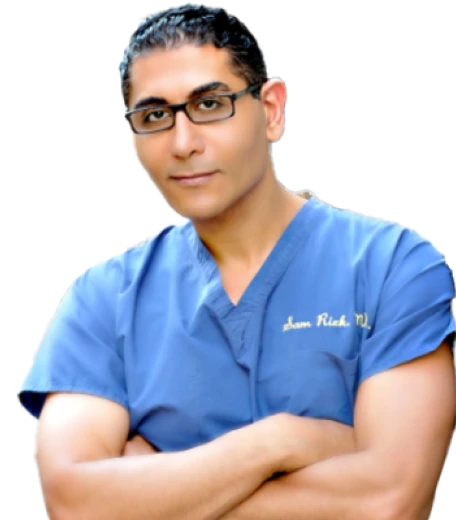
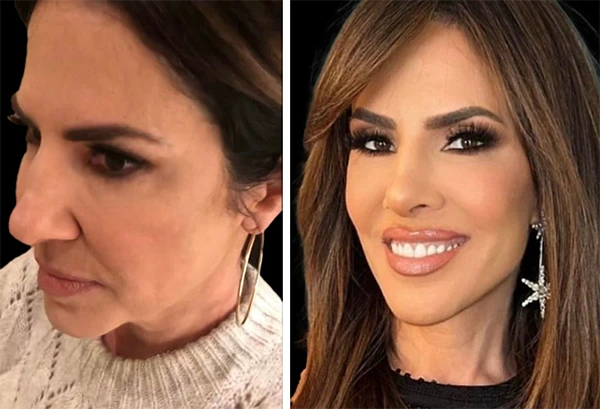
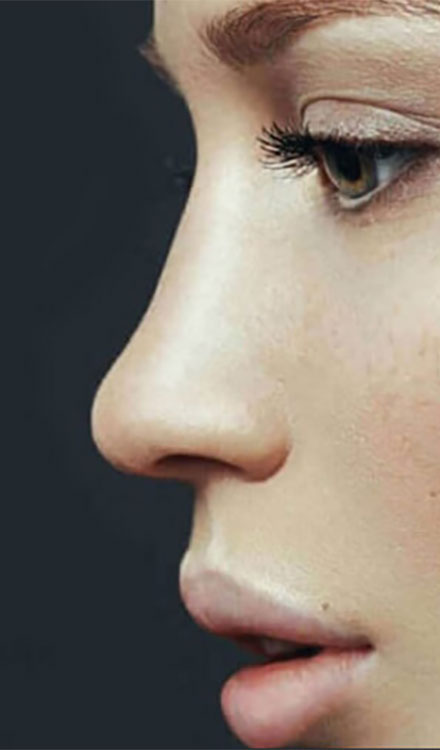
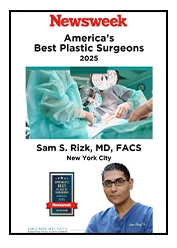
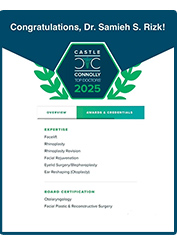
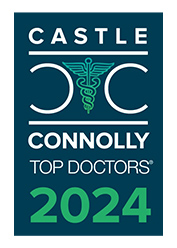

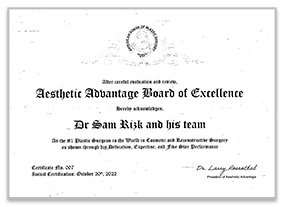
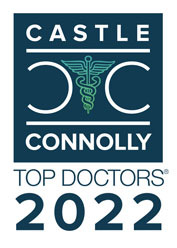

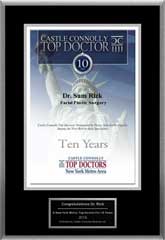
2.jpg)
